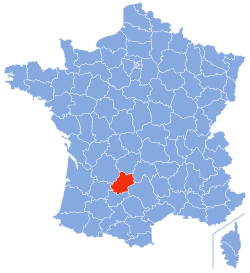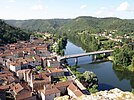Lot (department)
Department of France in Occitanie From Wikipedia, the free encyclopedia
Lot (French pronunciation: [lɔt];[3] Occitan: Òlt [ɔl]) is a department in the Occitanie region of France. Named after the Lot River, it lies in the southwestern part of the country and had a population of 174,094 in 2019.[4] Its prefecture is Cahors; its subprefectures are Figeac and Gourdon.
Lot
| |
|---|---|
From top down, left to right: Figeac, Rocamadour, Faycelles, Lot River, prefecture building in Cahors and Luzech | |
 Location of Lot in France | |
| Coordinates: 44°35′N 01°35′E | |
| Country | France |
| Region | Occitanie |
| Prefecture | Cahors |
| Subprefectures | Figeac Gourdon |
| Government | |
| • President of the Departmental Council | Serge Rigal[1] |
| Area | |
| • Total | 5,217 km2 (2,014 sq mi) |
| Population (2021)[2] | |
| • Total | 174,942 |
| • Rank | 93rd |
| • Density | 34/km2 (87/sq mi) |
| Time zone | UTC+1 (CET) |
| • Summer (DST) | UTC+2 (CEST) |
| Department number | 46 |
| Arrondissements | 3 |
| Cantons | 17 |
| Communes | 313 |
| ^1 French Land Register data, which exclude estuaries, and lakes, ponds, and glaciers larger than 1 km2 | |
History
Lot is one of the original 83 departments created during the French Revolution on 4 March 1790. It was created from part of the province of Quercy. In 1808 some of the original southeastern cantons were separated from it to form the department of Tarn-et-Garonne. It originally extended much farther to the south and included the city of Montauban.
Geography

Lot is part of the region of Occitanie and is surrounded by the departments of Corrèze, Cantal, Aveyron, Tarn-et-Garonne, Lot-et-Garonne and Dordogne. It is named after the river Lot, which in its Occitan name is Olt.
Cahors is the prefecture of the department, lying in its southwestern part: a medieval cathedral town known internationally for its production of Cahors wine, it lies in a wide loop of the Lot River and is famous for its 14th-century bridge, the Pont Valentré. Figeac is a medieval town where Jean-François Champollion, the first translator of Egyptian hieroglyphics, was born, situated in the eastern part of Lot. Gourdon, a medieval hilltop town located in Lot's northwestern part, with a well preserved centre, comprises many prehistoric painted caves nearby, notably the Grottes de Cougnac.
Principal towns
The most populous commune is Cahors, the prefecture. As of 2019, there are seven communes with more than 3,000 inhabitants:[4]
Demographics
The inhabitants of Lot are called Lotois and Lotoises in French. Population development since 1801:
|
| ||||||||||||||||||||||||||||||||||||||||||||||||||||||||||||||||||||||||||||||||||||
| |||||||||||||||||||||||||||||||||||||||||||||||||||||||||||||||||||||||||||||||||||||
| Sources:[5][6] | |||||||||||||||||||||||||||||||||||||||||||||||||||||||||||||||||||||||||||||||||||||
Politics
Departmental Council of Lot
The Departmental Council of Lot has 34 seats. Since the 2015 departmental elections, 30 are controlled by the Socialist Party (PS) and its allies; four are controlled by the miscellaneous right. Since 2014, the President of the Departmental Council has been Serge Rigal, currently a member of La République En Marche! (REM).
Members of the National Assembly
Lot elected the following members of the National Assembly during the 2017 legislative election:
| Constituency | Member[7] | Party | |
|---|---|---|---|
| Lot's 1st constituency | Aurélien Pradié | The Republicans | |
| Lot's 2nd constituency | Huguette Tiegna | La République En Marche! | |
Senators
Lot is represented in the Senate by Angèle Préville (since 2017) and Jean-Claude Requier (since 2011).
Tourism
See also
References
External links
Wikiwand in your browser!
Seamless Wikipedia browsing. On steroids.
Every time you click a link to Wikipedia, Wiktionary or Wikiquote in your browser's search results, it will show the modern Wikiwand interface.
Wikiwand extension is a five stars, simple, with minimum permission required to keep your browsing private, safe and transparent.













